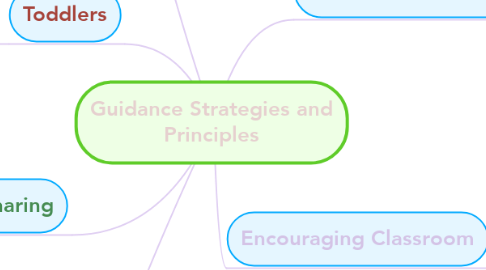Guidance Strategies and Principles
by Cory Petersen


1. Anger
1.1. Anger may mean:
1.1.1. Frustration
1.1.2. Disappointment
1.1.3. Hurt
1.1.4. Fear
1.2. Children need opportunities to be angry and properly show it.
2. Toddlers
2.1. "If you're in my way, I'll move you"
2.2. They need consistent caregiving
2.3. They need routines
2.4. They need to be attached to those they love and trust
2.5. They are always exciting
3. Sharing
3.1. They need to have opportunities to have ownership of items/toys
3.2. You should provide multiples of everything
3.3. Don't make them share
3.4. Let them keep it until they are done. Don't take it away
3.5. Children are egocentric, not selfish
4. ADHD
4.1. Most commonly diagnosed disorder
4.2. Adults think it's the easy way out for children
4.3. If you have 3 or more of these, you'll most likely get labeled with ADHD
4.3.1. Fidgeting
4.3.2. Speaking out of turn
4.3.3. Not good at making friends
4.3.4. Easily distracted
4.3.5. Doesn't like to share
4.3.6. Doesn't like taking turns
5. Communication (Do's instead of Don't
5.1. Self-resepct
5.2. Healthy relationships
5.3. Problem Solving SKills
5.4. "Walk" instead of "We don't run"
6. Encouraging Classroom
6.1. Five-Finger formula
6.2. Teachers need support systems
6.3. Teachers should partner with families
6.4. Classic conflict management
6.4.1. Make both children equal parts of the "settlement"
6.5. Guidance talk
6.5.1. Figure out how to make the situation better for everyone
6.6. Class meeting
6.6.1. Discuss routines and other issues that may have arose in the classroom
6.7. Comprehensive Guidance
6.7.1. Children are not bad
6.7.2. They are all different
6.7.3. Their behaviors are all different
